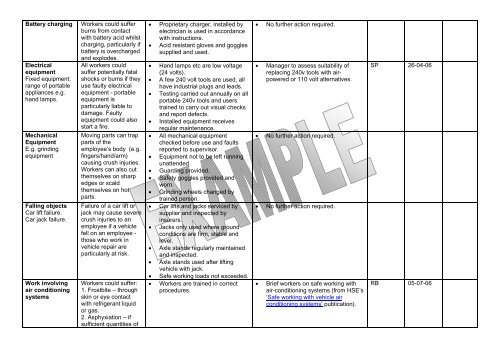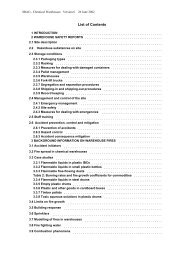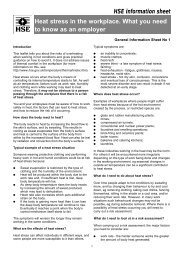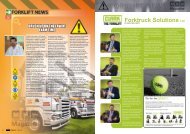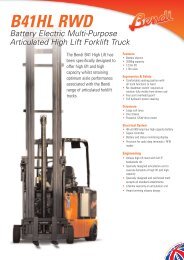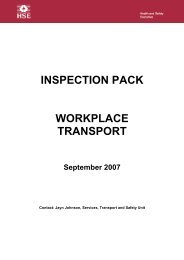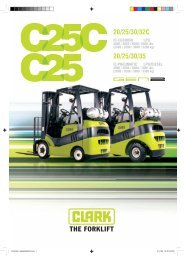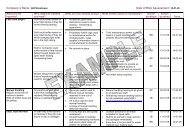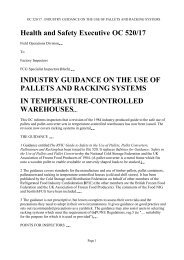Motor vehicle repair example document - Forktruck Solutions Ltd.
Motor vehicle repair example document - Forktruck Solutions Ltd.
Motor vehicle repair example document - Forktruck Solutions Ltd.
Create successful ePaper yourself
Turn your PDF publications into a flip-book with our unique Google optimized e-Paper software.
Battery charging<br />
Electrical<br />
equipment<br />
Fixed equipment;<br />
range of portable<br />
appliances e.g.<br />
hand lamps.<br />
Mechanical<br />
Equipment<br />
E.g. grinding<br />
equipment<br />
Falling objects<br />
Car lift failure.<br />
Car jack failure.<br />
Work involving<br />
air conditioning<br />
systems<br />
Workers could suffer<br />
burns from contact<br />
with battery acid whilst<br />
charging, particularly if<br />
battery is overcharged<br />
and explodes.<br />
All workers could<br />
suffer potentially fatal<br />
shocks or burns if they<br />
use faulty electrical<br />
equipment - portable<br />
equipment is<br />
particularly liable to<br />
damage. Faulty<br />
equipment could also<br />
start a fire.<br />
Moving parts can trap<br />
parts of the<br />
employee’s body (e.g.<br />
fingers/hand/arm)<br />
causing crush injuries.<br />
Workers can also cut<br />
themselves on sharp<br />
edges or scald<br />
themselves on hot<br />
parts.<br />
Failure of a car lift or<br />
jack may cause severe<br />
crush injuries to an<br />
employee if a <strong>vehicle</strong><br />
fell on an employee -<br />
those who work in<br />
<strong>vehicle</strong> <strong>repair</strong> are<br />
particularly at risk.<br />
Workers could suffer:<br />
1. Frostbite – through<br />
skin or eye contact<br />
with refrigerant liquid<br />
or gas.<br />
2. Asphyxiation – if<br />
sufficient quantities of<br />
• Proprietary charger, installed by<br />
electrician is used in accordance<br />
with instructions.<br />
• Acid resistant gloves and goggles<br />
supplied and used.<br />
• Hand lamps etc are low voltage<br />
(24 volts).<br />
• A few 240 volt tools are used, all<br />
have industrial plugs and leads.<br />
• Testing carried out annually on all<br />
portable 240v tools and users<br />
trained to carry out visual checks<br />
and report defects.<br />
• Installed equipment receives<br />
regular maintenance.<br />
• All mechanical equipment<br />
checked before use and faults<br />
reported to supervisor.<br />
• Equipment not to be left running<br />
unattended<br />
• Guarding provided.<br />
• Safety goggles provided and<br />
worn.<br />
• Grinding wheels changed by<br />
trained person.<br />
• Car lifts and jacks serviced by<br />
supplier and inspected by<br />
insurers.<br />
• Jacks only used where ground<br />
conditions are firm, stable and<br />
level.<br />
• Axle stands regularly maintained<br />
and inspected.<br />
• Axle stands used after lifting<br />
<strong>vehicle</strong> with jack.<br />
• Safe working loads not exceeded.<br />
• Workers are trained in correct<br />
procedures.<br />
• No further action required.<br />
• Manager to assess suitability of<br />
replacing 240v tools with airpowered<br />
or 110 volt alternatives.<br />
• No further action required.<br />
• No further action required.<br />
• Brief workers on safe working with<br />
air-conditioning systems (from HSE’s<br />
‘Safe working with <strong>vehicle</strong> air<br />
conditioning systems’ publication).<br />
SP<br />
RB<br />
26-04-06<br />
05-07-06


